Kuku-yalanji, Kunjen, Kuuku-ya’u and Yidinjdji Country
This the final section of the five week Queensland trip covers travel from Julatten in the Northern Tablelands up the magnificent Cape York Peninsula and into the rainforest of the Iron Range National Park.
Continued from:- Queensland Wildlife 2019 – Part 3 of 4 – The Southern Atherton Tablelands and Undara Lava Tubes.
Kingfisher Park and Mount Lewis
Kingfisher Park at Julatten in primarily a birdwatchers lodge. It is set in rainforest, but also has a tropical orchard on grounds, and as such not only has great birds but also reptiles, frogs and mammals. I had stayed here previously in 2016 and was well looked after by Carol and Andrew who are great hosts.
On arrival I got the low down on what was currently being seen at Kingfisher Lodge, afterwards visited a roosting Eastern Horseshoe Bat on the property after directions from Andrew. It was a privilege to be able to observe a Microbat at such close quarters and provided I used red light the Bat wasn’t at all worried.
Eastern Horseshoe Bat.
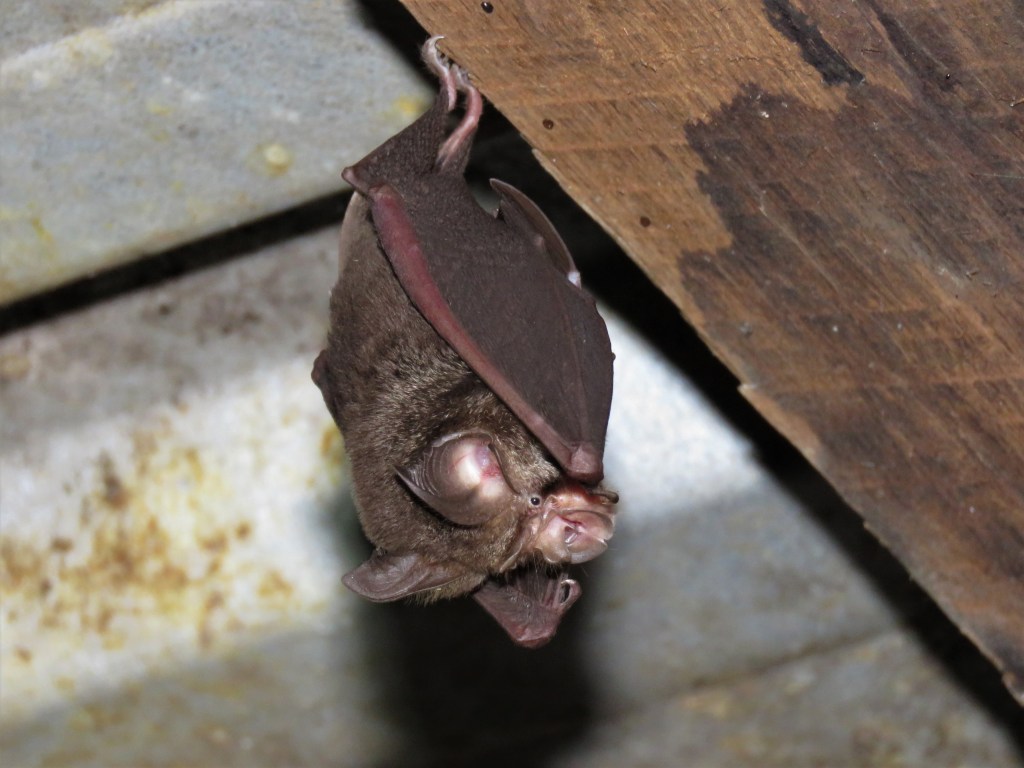
This visit at I was staying at the bunkhouse and after unpacking I went for a late afternoon drive around Julatten finding lots of Red-legged Pademelons out and about in the cloudy overcast conditions.
Red-legged Pademelon.

Back at Kingfisher Lodge orchard I was pleased to find the South American Sapote Tree flowering, and I hoped that in common with the last visit there would be lots of nightime mammals enticed to this rich nectar source. If the number of daytime birds attracted to it was any indication things were looking good.
Flowering South American Sapote Tree.

Spotlighting over three nights at Kingfisher Lodge the mammals were indeed excellent. Eastern Blossum Bats were consistently in high numbers in the Sapote Tree although it was necessary to view them under a red light, while the fruiting Guava Tree was attracting Spectacled Flying-foxes.
The other mammals seen at night were Long-nosed Bandicoots, Bush Rats, Red-legged Pademelons, Agile Wallabies, Giant White-tailed Rats and a Prehensile-tailed Rat. The only mammal seen during daylight hours was a Yellow-footed Antechinus in the camp kitchen, with excellent views as it foraged around.
All three nights spotlighting the orchard I came across Leaf-tailed Gecko. This species is usually seen on tree trunks, but one particular animal was always foraging on the ground. I had to keep my wits about me to avoid stepping on it.
Leaf-tailed Gecko.


The first two days of my visit conditions were wet but this ensured good numbers of frogs spotlighting with Northern Stony-creek Frogs, Northern Barred Frogs as well as the much maligned Cane Toad.
Northern Stony-creek Frog.

I saw two interesting birds around the grounds of Kingfisher Lodge after dark and these were were a Lesser Sooty Owl and Papaun Frogmouths. The Papuan Frogmouths could also be seen in the daytime when they were roosting around the orchard.
Roosting Papuan Frogmouths.

There was no shortage of daytime birds at Kingfisher Lodge it was a joy to sit near the feeders and watch all the different species come in to feed.
Clockwise from left:- Blue-faced Honeyeater, Macleay’s Honeyeater, Emerald Dove.



I had read of nearby Mount Lewis being a good site for the Daintree River Possum, the only one of the larger rainforest possums I had yet to see on the trip.
Mount Lewis however, can be a cruel mistress. The 26km access road is only good as far as 10km in a coventional vehicle, and although the Daintree River Possum has been seen at this altitude the mountain is often cloaked in cloud and mist, terrible conditions for spotlighting.
The first night of my stay I drove up Mount Lewis but by the 4km mark I was already in the cloud so I turned around. The second night with conditions worse I didn’t even attempt it. Despite only getting to 4km on the first night I did find a Lesser Sooty Owl, a new species for me and a beautiful Owl.
Lesser Sooty Owl.
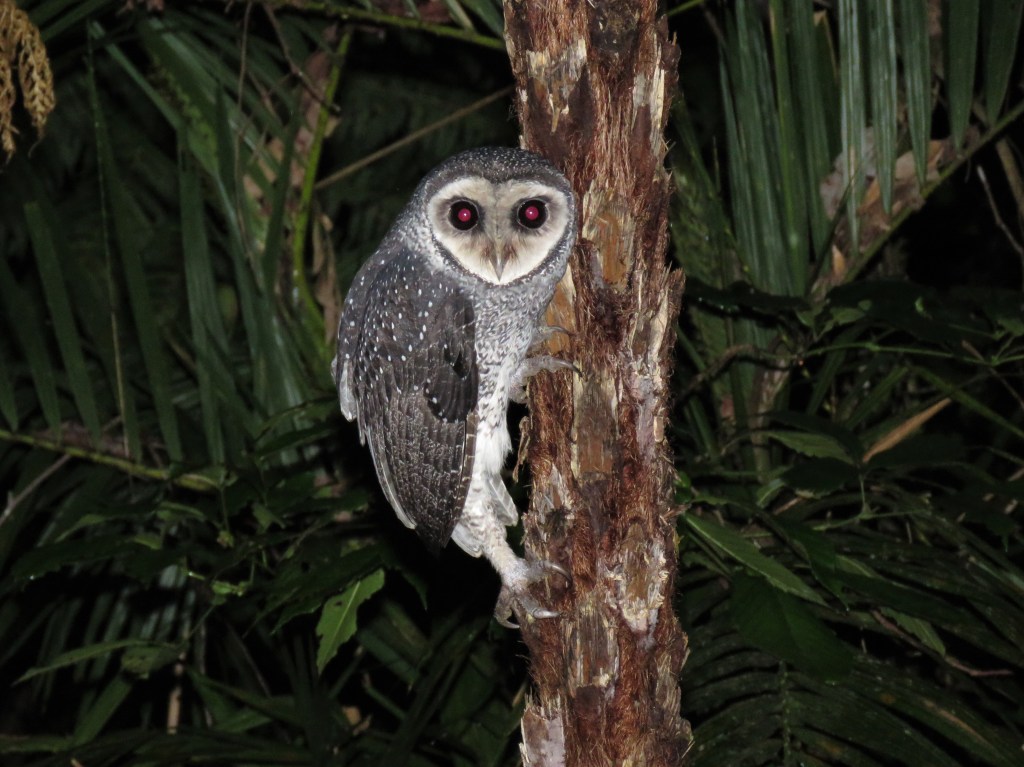
The last full day at Mt Lewis was at last a sunny one and I wasn’t surprised to find the resident Eastern Water Dragon basking on a log at the creek at the end of the property.
Eastern Water Dragon.

The third and final night at Kingfisher Lodge I attempted Mount Lewis again, this time getting to the clearing and seeing a Long-nosed Bandicoot, Red-legged Pademelon and Giant White-tailed Rat on the ascent. It was a beautiful evening with bands of high cloud lit up by a half-moon.
I walked from the clearing further up the road for about 2km and positively identified 4 Green Possums. The trees were quite large beyond the clearing and the canopy thick so I was unable to identify two other sets of eyeshine. I suspected at least one of them was a Daintree River from colouration but couldn’t be certain.
Back at the clearing there was a Rufous Boobook Owl sitting in a tree right next to the parked car. The red colouration was unlike that of any other Boobook I had ever seen.
Boobook Owl.

Friday morning I drove 90 minutes back to Cairns to swap the SUV for a 4WD, necessary for driving on the Cape York Peninsula. I previously visited the bat cave at Wangetti Beach when a single animal was present. This time numbers were much healthier and there were 15-20 Coastal Sheathtails hanging on the sheer walls of the cleft.
Coastal Sheathtail Bats.
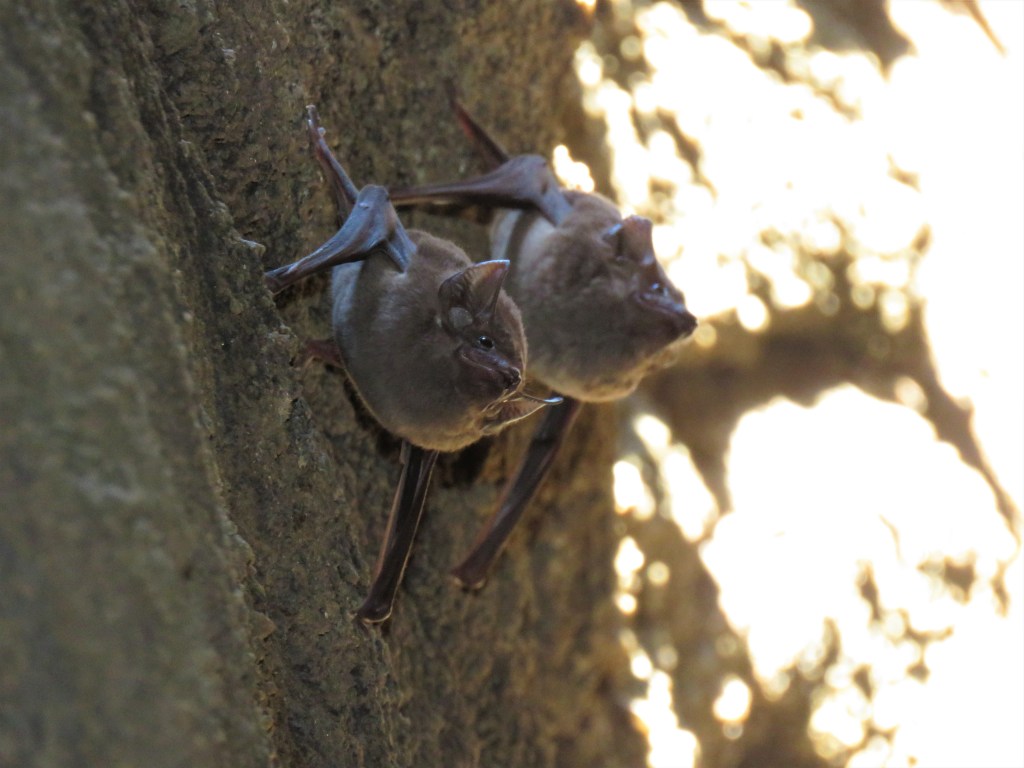
I retraced my route Northwards in the 4WD past Julatten and on to the Mulligan Highway. Finally I was heading up the Cape York Peninsula.
Cape York

My first stop on the peninsula was Shipton’s Flat near Cooktown. At he entrance to Springvale Staion past Lakeland I saw three Bustards.
Bustard.

Cooktown Area
I arrived at my accomodation at Mungumby Lodge mid afternoon and managed a nap before heading to nearby Black Mountain late afternoon. The mountain itself is a mass of large granite boulders with an absence of soil between the boulders. Light was failing and it was to late to explore so I elected to return the following morning.
Early to bed, early to rise and I was back at Black Mountain before sunrise. I found it quite an atmospheric place pre-dawn, the only sound being the screech of Sulphur-crested Cockatoos. Black Mountain is known to be a reliable site for the Godman’s Rock Wallaby but I didn’t see any, there again I didn’t explore very far from the viewing platform, cautious of the treacherous terrain on my own.
Dawn at Black Mountain and a Sulphur-crested Cockatoo.

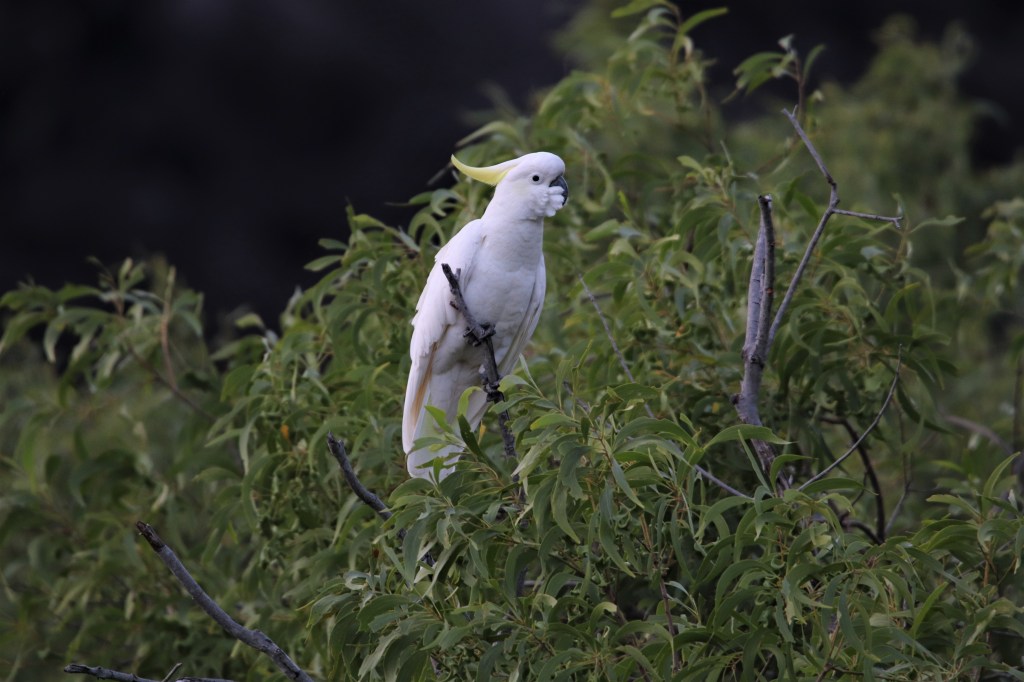
Later that morning I met up with Lewis Roberts to search an area near Mount Misery for Bennett’s Tree Kangaroos. Despite five hours of searching we dipped. However, spending time with an inspirational and extremely knowledgable bushman like Lewis Roberts was my absolute pleasure. Lewis gave more information on sites for wildlife viewing on Cape York than I could ever have hoped to source from anywhere else.
On the return trip to town I stopped at the Roberts property and had fantastic views of Fig Parrots and a roosting Owlet Nightjar.
Owlet Nightjar.
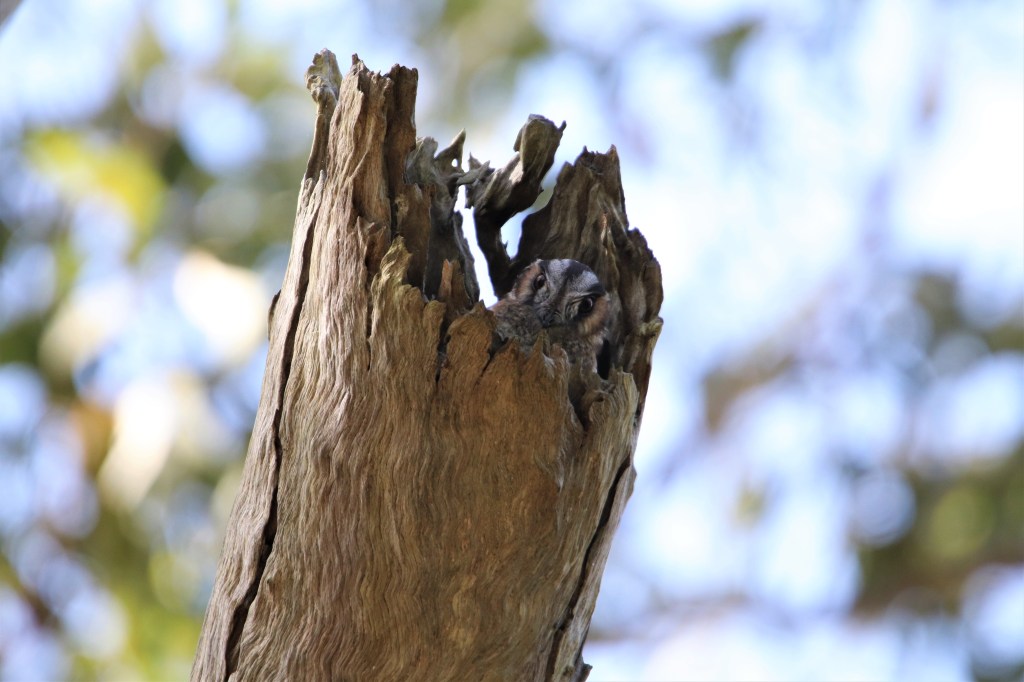
I visited Little Annan Gorge late afternoon on the advice of Lewis and cracked a Godman’s Rock Wallaby on the right hand side of the gorge downstream from the road.
That evening I drove around the roads behind Shipton’s Flat searching for the Northern Quoll and it didn’t take long to find one. It was the middle of the mating season at the time of my visit and this Quoll was a battle-scarred male. I had also saw this species freshly killed on the road near Black Mountain early that morning.
Lewis had told me earlier in the day that the Northern Quoll was thought extinct from the area for decades before the numbers recovered to the healthy population it is today. Hopefully setting a precedent for the rest of Northern Australia, where populations of Northern Quolls have crashed after the spread of the Cane Toad.
Northern Quoll.

The following morning I drove the Peninsula Developmental Road (PDR) North. The road was sealed completely as far as Laura where I dropped my tyre pressures. North of Laura the road alternated between sealed and unsealed, although the unsealed sections were not very corrugated and would have been ok in 2WD in the dry conditions.
I decided to overnight at the busy campground at Musgrave River Roadhouse. After setting up the tent I had an explore around the area and found the lagoons behind the campground contained Freshwater Crocodiles.
Freshwater Crocodile.
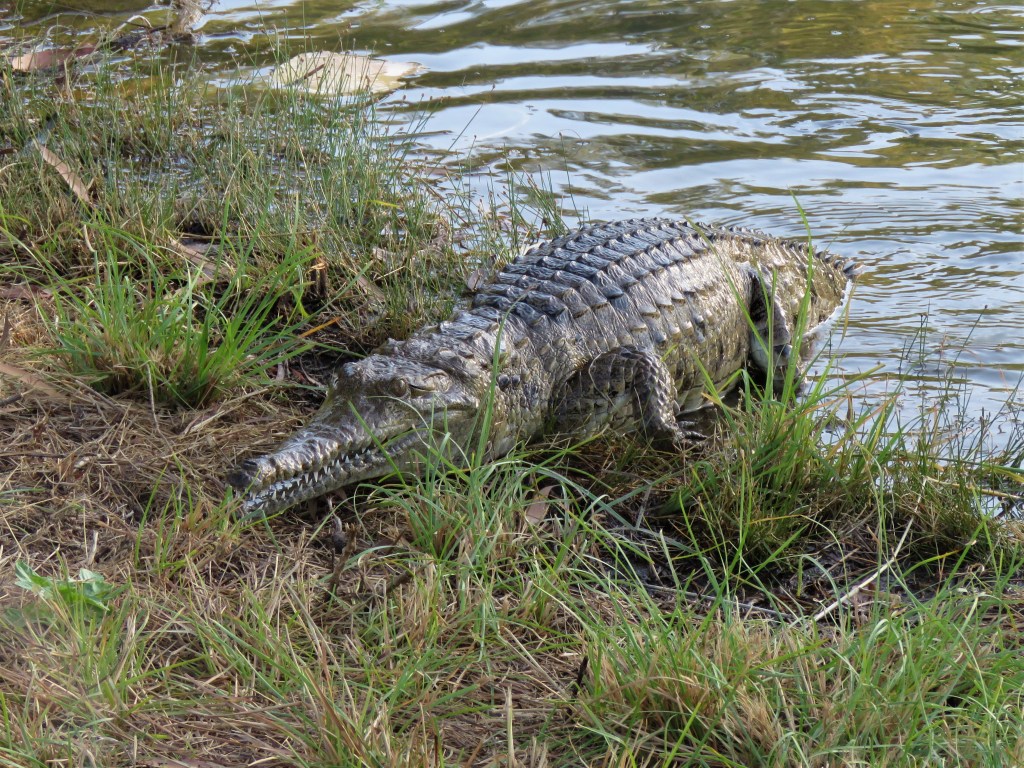
Agile Wallabies were plentiful on the airstrip late afternoon, but I didn’t find any Northern Nailtail Wallabies seen on other trip reports at Musgrave River Roadhouse.
Agile Wallabies.
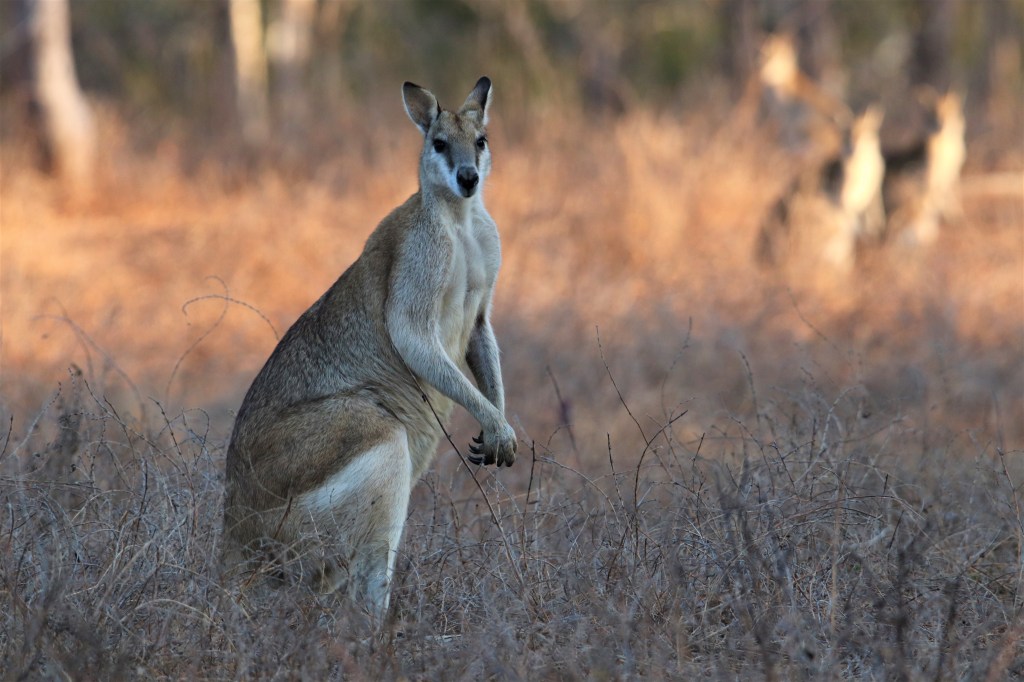
The following morning was an early start to continue on the PDR North. Where the PDR passes over the Bamboo Range I stopped in suitable habitat to look for the Cape York Rock Wallaby, time was not on my side however and I had to press on after a quick unsuccessful search.
The road between Musgrave River Roadhouse and Coen was an absolute shitfight in places. There were still long sealed sections but the unsealed sections were very rough with sudden dips and a lot of dust from oncoming vehicles. This section of the PDR was by far the worst road I travelled on the Cape.
I saw my first wildlife of the day with a Common Wallaroo grazing at the side of the road South of Coen.
Common Wallaroo.
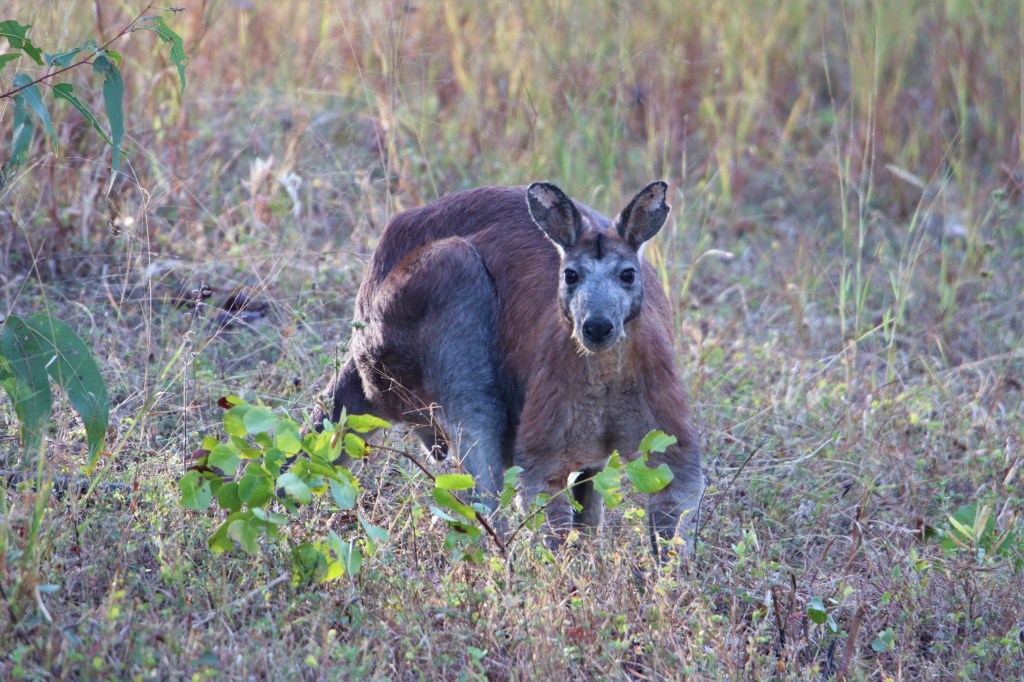
The Portland Road turnoff for the Iron Range NP is 36km North of Archer River Roadhouse. Portland Road is a more scenic drive than the PDR especially between the Wenlock and Pascoe Rivers. There were a number of creek and river crossings but all were low during the time of my visit.
Creek Crossing Portland Road.

Iron Range National Park ( Kutini-Payamu)
Map showing location of Iron Range National Park.
The Iron Range National Park protects the largest remaining tract of lowland rainforest in Australia. but the park was a shadow of its former self. Five months previously in March, Cyclone Trevor had smashed into the Queensland Coast at Lockhart River, and 10 hours of gale force winds had stripped all of the vegetation from the trees.
I had learned of this event on the travelling grapevine further down the coast and briefly considered changing my plans, but after hearing from birders that the lack of vegetation had made birdwatching (of the remaining species anyway) easier, I hoped this would also be the case for mammals.
On the drive into the park I stopped at the Mount Tozer Lookout, everything looked ok here, what was the worry about? It was only when I turned around and saw a hill covered in bare tree trunks that I realised I was looking at the devastating effects of Trevor.
Mount Tozer.
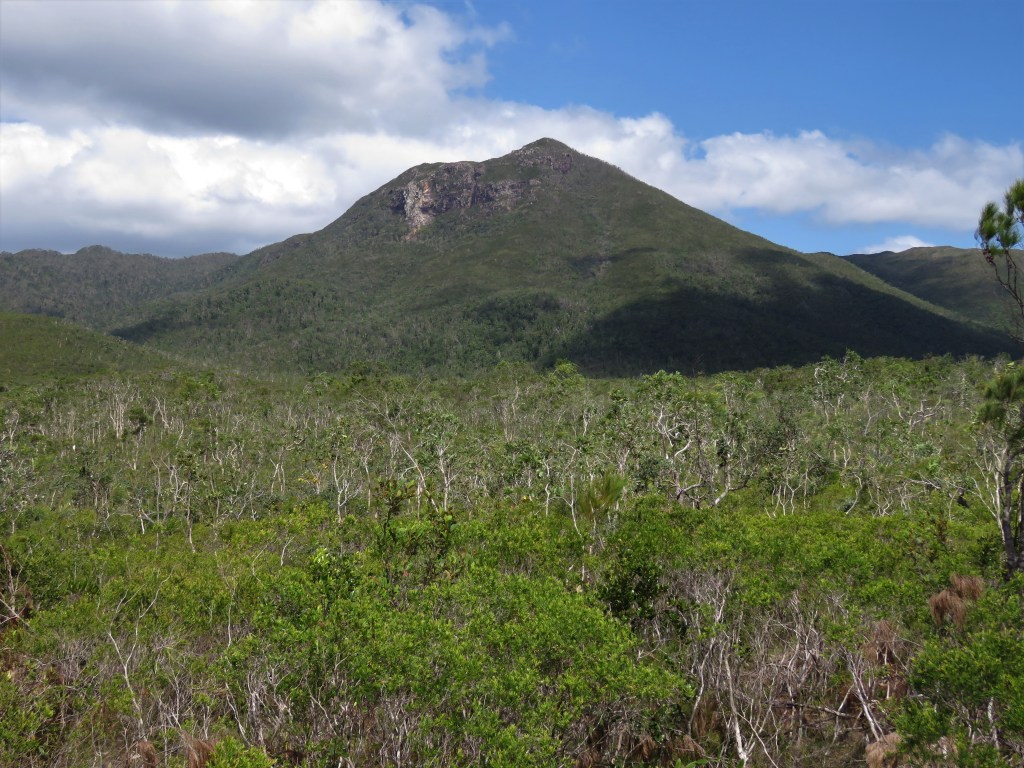
As I crossed the Claudine River into the park proper I could see the extent of the damage of the cyclone. It was a scene of utter annihilation.
The Impact of Cyclone Trevor.

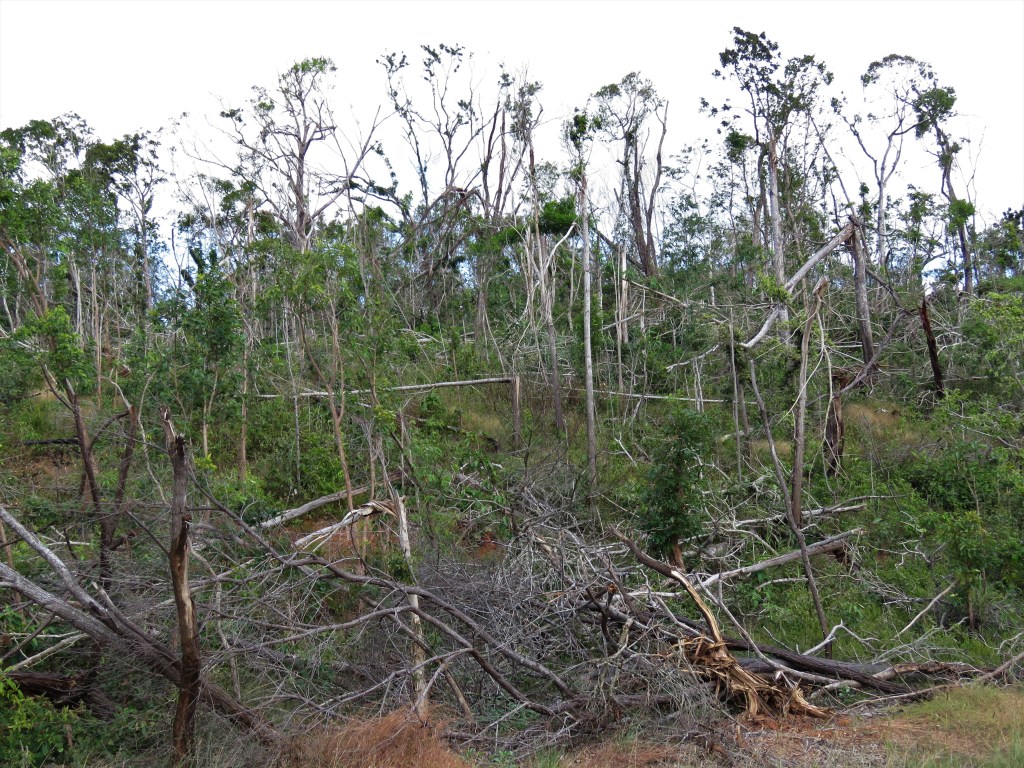
I booked a campsite at the Iron Range online well in advance of the travel as recommended, although it was hard to decide which campsite would be best suited to view wildlife.
The campsites at Chilli Beach are by far the most popular in the park, they are close to the settlement of Portland Roads but Chilli Beach is over 30km from the rainforest where there is the best chance of seeing wildlife.
Chilli Beach.

All of Gordon Creek, Cooks Hut and Rainforest Campsites are within (usually) excellent rainforest habitat and within walking distance of each other. Gordon Creek and Rainforest Campsites are the most private, Cooks Hut is a larger open camping area and contains the only toilet for the three campsites.
I had booked Gordon Creek but found on arrival there was no shade post cyclone, so I stayed only one night, relocating to nearby Cooks Hut Camspite for the second and third nights. Here the vegetation was more intact.
Th wildlife of the Iron Range has much in common with that of nearby Papua New Guinea, the result of a land bridge between the two 11,000 years ago.
All three nights I spotlighted on foot the rainforest from South of Gordon Creek Campsite North to Rainforest Campsites.
On the first night it took me three hours to get my eye in and find the first Cuscus, it was a Common Spotted Cuscus. This was by far the more common of the two Cuscus species in the park with 8 animals seen over the three nights.
Common Spotted Cuscus.

The area around Cooks Hut was the best for this species and although they were often higher up in trees I had was lucky to find a mother and juvenile feeding relatively lower down near the toilet on the second night.
Juvenile Common Spotted Cuscus

Cape York Melomys were another species commonly encountered, especially in vine thickets. On the first night I even had one jumping on my tent at Gordon Creek Campsite!
Cape York Melomys.

The second species of Cuscus is the Southern Common Cuscus which I found much less common than the Common Spotted Cuscus, confused by the names I was! I had an entirely unsatisfactory encounter with this species on the second night when an animal was high up in (a rare bit of) thick canopy. I was able to see enough to make out the distinctive head stripe to identify the species but that was all.
On the spotlight on the final night just East of Gordon Creek Campsite I found a second animal low down on a bare branch enabling much clearer views.
Southern Common Cuscus.

The other mammals seen at Iron Range were a Cinnamon Antechinus at Gordon Creek Campsite, a Dingo, Feral Pigs, a Long-nosed Bandicoot and a Red-legged Pademelon. Flying-foxes were common high up in the trees and flying overhead, but the only species I could identify was the Spectacled Flying-fox.
I was constantly accompanied by a pair of inquisitve Large-tailed Nightjars on all three nights walking along the road between the campsites.
Large-tailed Nightjar.

Iron Range frogs were excellent, with the highlight being the endearing White-lipped Tree Frogs, often seen very high up in vegetation.
White-lipped Tree Frog.
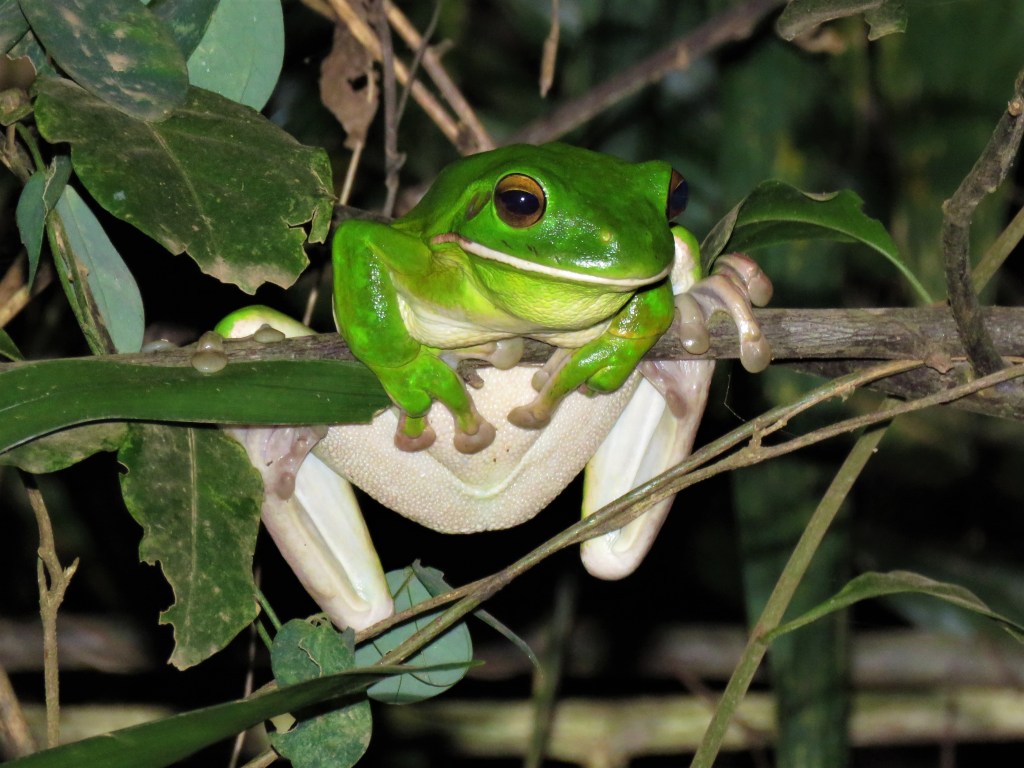
Other fantastic Frogs seen while spotlighting included left to right:- Cape York Graceful Tree Frog, Hylarana daemali and the Green Tree Frog.


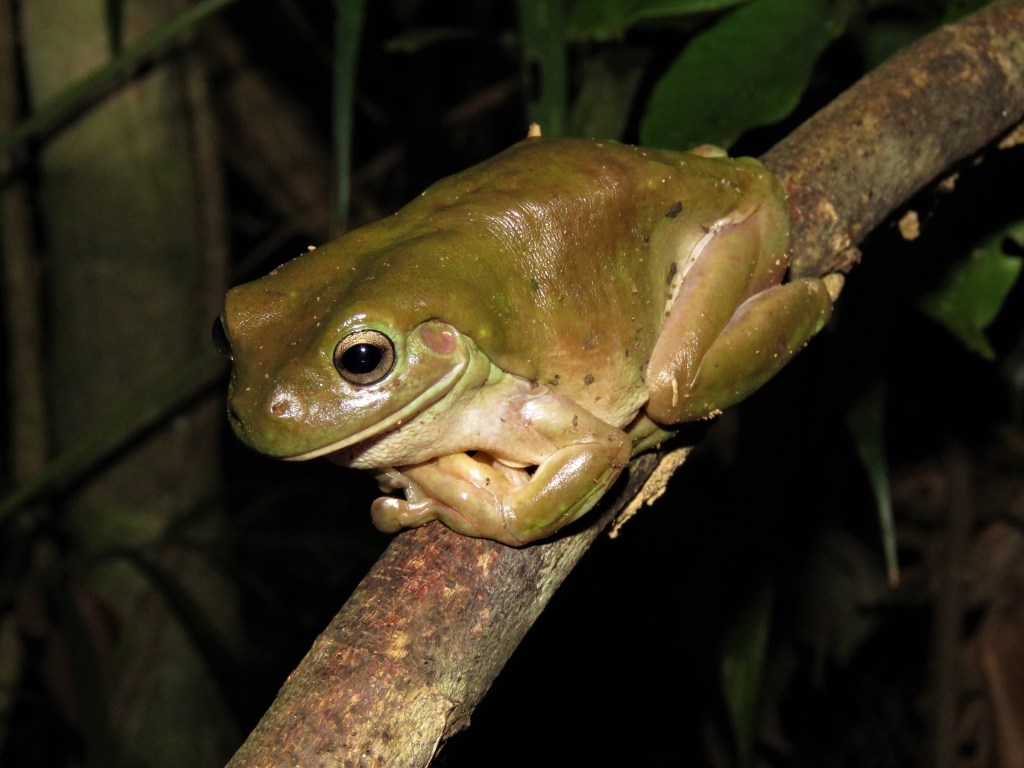
It had been an absolute highlight to visit Iron Range National Park and see the amazing species that call the park home. I have no doubt the effects of the recent cyclone aided viewing mammals in otherwise thick rainforest, although it is probable that numbers of animals were down but I have nothing to compare.
Storm Brewing – Iron Range.

I made the long arduous drive back down the Cape in a day and it worth mentioning large sections of the PDR are being sealed as far North as the Portland Road turnoff and probably beyond to Weipa. This can only be good news for future visitors to Cape York.
I decided to return to Kingfisher Lodge for the final night on the road, in part because with a 4WD drive I could access further up Mount Lewis to have another shot at the Daintree River Possum.
Mount Lewis and return to Kingfisher Park
Conditions were not ideal as I drove in an out of mist and cloud ascending Mt Lewis but I was lucky that large North facing sections of the mountain were unaffected by the weather. At 17kms the cloud was too dense to continue so I turned around and spotlighted at 16km and 14km on the descent and finally had good views of 2 Daintree River Possums.
Daintree River Possum.
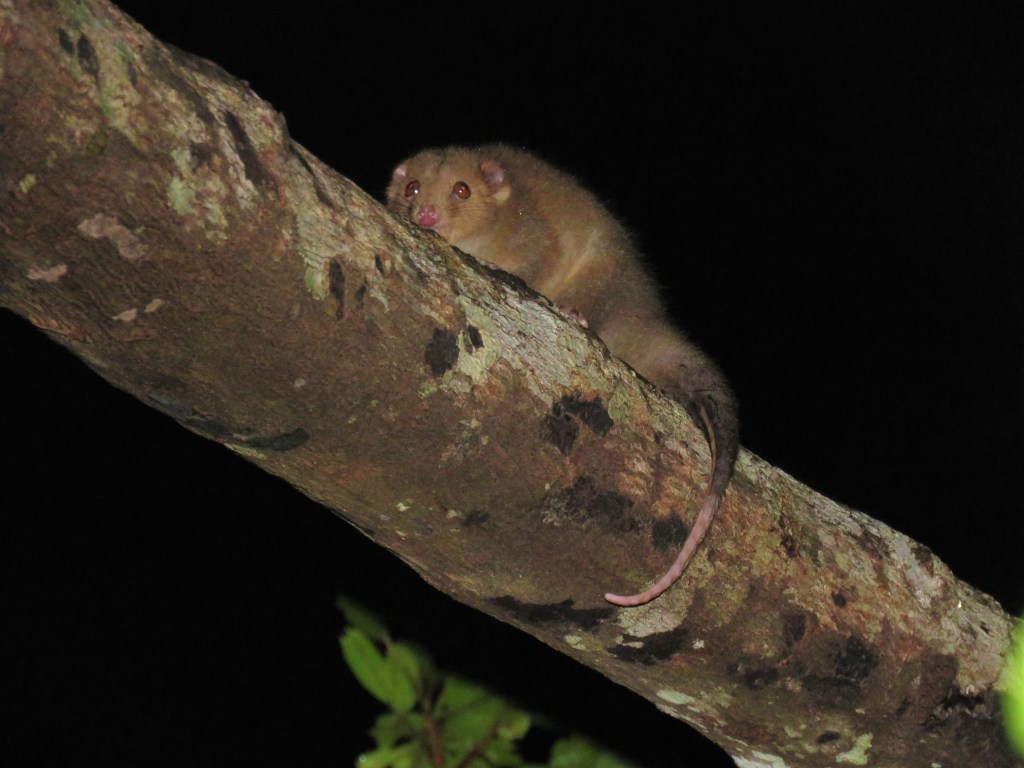
My final species of frog for the trip was the beautiful Green-eyed Tree Frog quite common on Mt Lewis and indeed throughout the Atherton Tablelands.

Back at Kingfisher Lodge despite the late hour a quick spotlight at the orchard was impossible to resist. I saw a 2.5m Amethystine Python waiting patiently for visitors at the base of the Sapote Tree as well as 2 Striped Possums and the usual Eastern Blossum Bats, Agile Wallabies, Red-legged Pademelons and Long-nosed Bandicoots. What a night!
Amethystine Python.
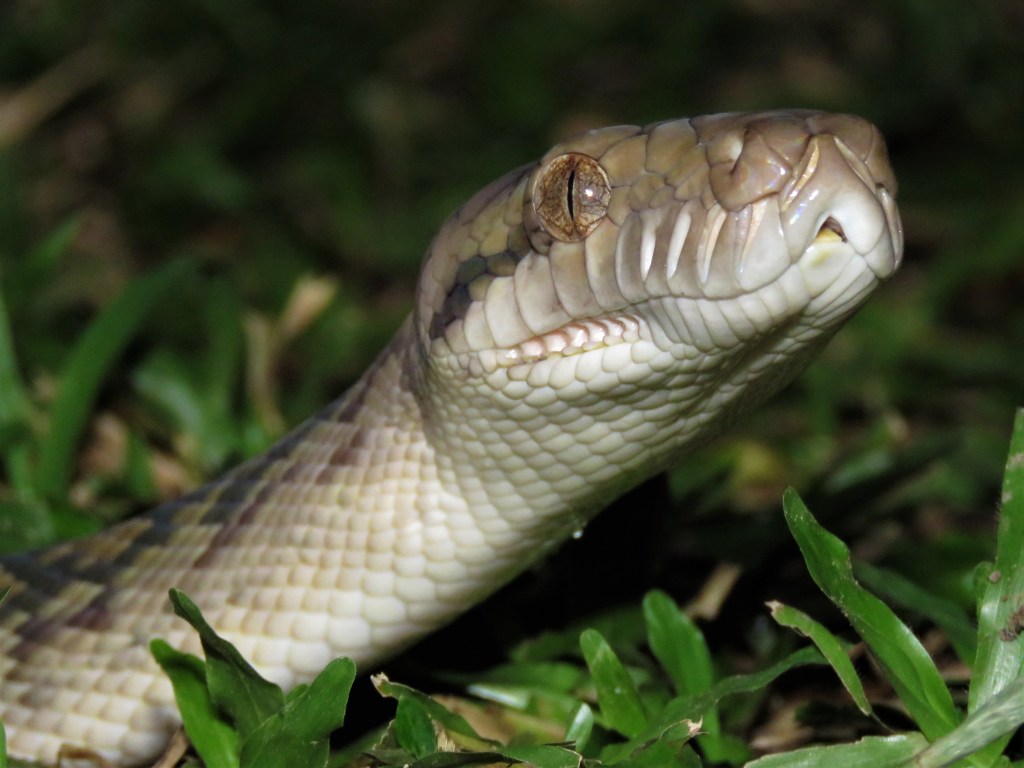

The following morning a little bleary eyed walking to the shower block I noticed the Brush Turkeys were acting very erratically, then I found out the reason why when I bloody nearly stepped on another (much larger) Amethystine Python cruising across the driveway to raid the Brush Turkey mound!
Amethystine Python.

I felt very blessed to see two Pythons in a 12 hour period and was on a high returning to Cairns. After returning the hire car and getting slugged for extra kilometres after having to sell body parts to hire the thing in the first place, I booked into a hotel for a long shower and soft bed.
Cairns
Needless to say I made the most of the excellent watering holes in Cairns over the weekend before flying back to Perth. I did some half-arsed mammal watching at the Cairns Botanical Gardens seeing Spectacled Flying-foxes, Giant White-tailed Rats, Long-nosed Bandicoots and Northern Brown Bandicoots. I also stopped at the Spectacled Flying-fox colony at the Cairns Library over the weekend.
Spectacled Flying-fox.

See here for a trip wildlife watching to Southeast Queensland:- Wildlife South East Queensland – Rainforest and Rock Wallabies.
It felt like an age ago that I stepped off the plane in Rockhampton and it had been amazing trip with 65 mammal species seen (I counted especially for you Jon Hall!) It could not have been so successful without the help and support of so many kind Queenslanders along the way. Also the excellent trip reports of Valentin Moser, Rohan Clark, Tim Bawden and previous contributors to Jon Hall’s excellent Mammalwatching website.
#QuollingAround
I’ve been following your journey on Mammal Watching and have really enjoyed the trip. What wonderful photography and informative posts! Thank you for sharing.
LikeLiked by 1 person
Many thanks for your kind words ramblingranger!
LikeLiked by 1 person
just realised I had never read the last part! Awesome report mate!
LikeLiked by 1 person
Cheers Tim!
LikeLiked by 1 person
What an interesting read!! Thanks for taking the time to write this James lamb!!
LikeLike